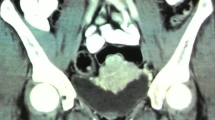Abstract
Objective
To study the diagnosis and treatment of pheochromocytoma in urinary bladder.
Methods
Six cases of bladder pheochromocytoma were studied. Four cases showed hypertension, 3 of which were paroxysmal hypertension during urination. Catecholamine (CA) was increased in a case, and vanillymandelic acid (VMA) was increased in 2 cases. Bladder submucosal mass was detected by B-ultrasound in 5 cases (5/5), computerized tomography (CT) in 3 cases (3/3), cystoscopy in 5 cases (5/6). Four cases took α-receptor blocker for 2 weeks, 1 case took β-receptor blocker to decrease heart rate. All patients were treated with surgical operation including 4 partial cystectomies, 2 excavations.
Results
Three cases had manifestations including headache, excessive perspiration and hypertension during cystoscopy. Four cases were confirmed before operation. Two cases showed hypertension during operation. All patients were pathologically diagnosed as pheochromocytoma postoperatively. In five cases followed up, blood pressure returned to normal. No patient had relapse and malignancy.
Conclusions
Typical hypertension during urination comprised the main symptoms. We should highly suspect bladder pheochromocytoma if a submucosal mass was discovered with B-ultrasound, CT, 131I-MIBG (methyliodobenzylguanidine) and cystoscopy. The determination of CA in urine is valuable for qualitative diagnosis. The preoperative management of controlling blood pressure and expansion of the blood volume are very important. Surgical operation is a good method for effective treatment. Postoperative long-time followed up is necessary.
Similar content being viewed by others
References
Baima, C., Casetta, G., Vella, R., Tizzani, A., 2000. Bladder pheochromocytoma: a 3-year follow-up after transurethral resection (TURB). Urol. Int., 65(3):176–178. [doi:10.1159/000064868]
Karpman, E., Zvara, P., Stoppacher, R., Jackson, T.L., 2000. Pheochromocytoma of urinary bladder: update on new diagnostic modalities plus case report. Ann. Urol., 34:113–119.
Ma, J.X., Zhu, R.S., Yu, J.F., Ding, C.D., Jing, C.Q., 1996. The value of diagnosis of aberrant and (or) malignant pheochromocytoma with 131I-MIBG imaging. Chinese Journal of Nuclear Medicine, 16:101–102.
Naqiyah, I., Dohaizak, M., Meah, F.A., Nazri, M.J., Sundra, M., Amram, A.R., 2005. Pheochromocytoma of the urinary bladder. Singapore Med. J., 46(7):344–346.
Onishi, T., Sakata, Y., Yonemura, S., Suqimura, Y., 2003. Pheochromocytoma of urinary bladder without typical symptoms. Int. J. Urol., 10(7):398–400. [doi:10.1046/j.1442-2042.2003.00645.x]
Seki, N., Mukai, S., Gamachi, A., Migita, T., Maeda, K., Ogata, N., 2001. A case of bladder pheochromocytoma. Urol. Int., 66(1):57–60. [doi:10.1159/000056569]
Walsh, P.C., Petik, A.B., Vanghan, E.D., 1998. Capbell’s Urology, 7th Ed. Philadelphia, Sauders.
Wu, J.P., 2003. Wujieping’s Urology, 1st Ed. Shandong Science and Technology Press, Ji’nan, p.987–989.
Author information
Authors and Affiliations
Rights and permissions
About this article
Cite this article
Liu, Y., Dong, Sg., Dong, Z. et al. Diagnosis and treatment of pheochromocytoma in urinary bladder. J. Zhejiang Univ. - Sci. B 8, 435–438 (2007). https://doi.org/10.1631/jzus.2007.B0435
Received:
Accepted:
Issue Date:
DOI: https://doi.org/10.1631/jzus.2007.B0435




